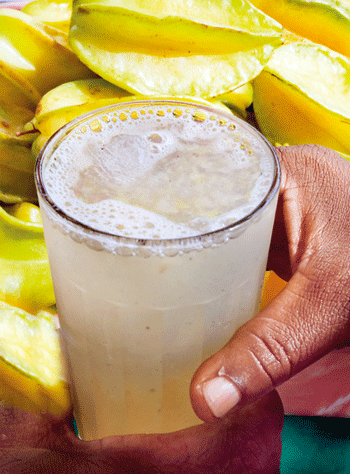If you are eating or drinking star fruit; stop and think

The fruit and juice. Pic by M.A. Pushpa Kumara
Beware – power-packed this fruit is, but it also oozes poison from its crunchy, tangy flesh.
Kamaranka by whatever name it may be called, star fruit, carambola, five-corner fruit or the scientific, Averrhoa carambola, is not essential in the human diet and should be scrupulously avoided.
For, it is a “potent” source of two destructive toxins which can harm the kidneys and the nerves, warns Consultant Nephrologist Dr. Eranga S. Wijewickrama attached to the National Hospital of Sri Lanka, reiterating that it is better to be safe than sorry and not eat kamaranka or sip its juice as it is not a “must” fruit.
As we cannot predict who will get hit, it is better to avoid kamaranka, is this Specialist’s advice, taking into account the ‘classic’ example of a healthy young executive who after a hard day’s work with little food had a long, cool draught of kamaranka. A few days later he was in hospital with kidney damage.
Kamaranka comes as a sweet as well as a sour variety and is promoted as being rich in anti-oxidants, potassium and Vitamin C which boost anti-microbial activities, while being low in sugar, sodium and acid. Antioxidants protect the body from damage caused by harmful molecules called free radicals and anti-microbial activities kill micro-organisms or stop their growth.
But kamaranka not only delivers the ‘good’ but also the ‘bad’, according to Dr. Wijewickrama who is also a Senior Lecturer at the Department of Clinical Medicine, Faculty of Medicine, University of Colombo. He speaks with evidence to back him up as they are treating people with acute kidney failure after a dose of kamaranka.
Unfortunately, kamaranka, with its so-called blood-sugar lowering ability, is being promoted as an excellent choice of fruit for diabetics, as they are advised against eating most others. No one is sure whether the blood-sugar lowering ability has been documented after strong research, it is learnt.
Those at ‘highest’ risk of getting hit by the adverse effects of kamaranka are those having kidney damage and ironically into this category falls diabetics. These patients may not even know that they already have renal impairment because a rise in creatinine markers shows up quite late. Creatinine is a delayed marker, according to Dr. Wijewickrama. But even “perfectly normal” people who just have half-a-glass of kamaranka juice can suffer acute kidney injury.

Dr. Eranga S. Wijewickrama
The ‘bad’ of kamaranka can be very harmful to the body, he says, pointing out that the fruit contains the nephrotoxin oxalic acid and the neurotoxin caramboxin. The more problematic is the sour variety which has more oxalic acid as opposed to the sweet variety which is less associated with renal complications. A nephrotoxin is a poisonous substance which curbs, damages or destroys the cells or tissues of the kidneys, while a neurotoxin does the same to nerve tissue.
“We have treated several patients who have gone into acute renal failure in the past few months or in simple terms acute kidney injury caused by the nephrotoxin which is in kamaranka. They have either eaten the fruit or taken a juice,” he points out.
Dr. Wijewickrama warns that the most ‘disturbing’ is that even after treatment, the affected person’s kidney function may not come back to normal, as it was before the kamaranka was taken.
The treatment includes emergency dialysis (the extraction of waste and excess water from the blood artificially, as the patient’s kidneys are not functioning). This helps to get the acute toxin load out of the body, says Dr. Wijewickrama and prevents renal failure as much as possible.
However, he warns that there is no drug to reverse kidney injury and “absolutely no guarantee” that the kidney will come back to normal after such an episode of poisoning. The indications are that there will be some degree of permanent kidney damage.
It is in the backdrop of kamaranka, a tropical fruit, being grown mainly in South Asia and South America and exported to Europe and the United States of America as an exotic delicacy that the popularity of the star fruit has increased in leaps and bounds.
Dr. Wijewickrama and other Consultants are hoping to submit a research paper to a reputed journal on the ill-effects of kamaranka shortly.
| How the fruit becomes toxic | |
| Kamaranka as a cause of kidney injury is not considered even by doctors, says Dr. Eranga Wijewickrama, who urges colleagues to have it on their checklist along with painkillers etc when taking the case history of patients. Those with kamaranka toxicity can present with hiccups (hiccoughs), nausea, irritability, agitation, reduced level of consciousness and seizures, he says, with hiccups being the commonest symptomvery suggestive of this toxicity. Creating an image of how the nephrotoxin, oxalic acid, is absorbed into the body causing havoc with the renal system, this Nephrologist says that once the kamaranka is eaten or drunk, the nephrotoxin, like all other food and drink, gets absorbed into the body through the gastrointestinal tract (the digestive system or the alimentary canal). Thereafter, this nephrotoxin filters through the kidneys depositing the oxalic acid in the vital renal tubules, blocking them and causing oxalic nephropathy. The renal tubule is a part of the nephron, the basic structural and functional unit of the kidney. The nephron also consists of a tuft of capillaries – glomerulus and the bowl-shaped Bowman’s capsule. A normal adult has about 0.8-1.5 million nephrons in each kidney. Nephron is derived from the Greek ‘nephros’ which means kidney. Taking up the neurotoxin, though it is not his specialty, Dr. Wijewickrama says that caramboxin, on the milder side, causes hiccups, and on the more harmful side, vomiting, agitation, alternating states of consciousness and sometimes also seizures, coma and even death. The “intoxication” from kamaranka can occur by:
Pointing out how it works, Dr. Wijewickrama says that oxalic acid, usually gets bound to calcium and magnesium in our food, forming complexes of calcium and magnesium oxalate, preventing a large amount of oxalic acid from getting absorbed through the gastrointestinal tract. However, if kamaranka is eaten on an empty stomach, the formation of the calcium and magnesium oxalates does not occur, allowing large amounts of free oxalic acid to get absorbed, leading to nephrotoxicity.
|


